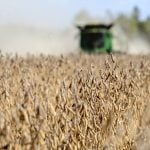Canola growers have often waited out the winter market to try to catch the dependable spring price rally.
That strategy will not likely work in the future, market analysts say.
Instead of worrying about starving over the summer after U.S. soybean stocks are used up, vegetable oil buyers now expect to feast, or at least get by, on South American soybeans.
“South America is there now in a big way, and the buyers and the market know that,” said canola analyst Nolita Clyde of Statcom Ltd.
Read Also

Chinese offer complicates canola marketing
Recently the Chinese ambassador indicated that there would be a potential deal between Canada and China regarding the current tariff war.
If South America produces average crops in the spring, vegetable oil prices then will have little reason to rally, and canola is unlikely to see significant rises.
“If they get reasonable weather, there’s no doubt that come spring the market will start to duck,” said Errol Anderson of Pro Market Communications.
“The buyers realize that once that new crop comes on stream in the spring, in late April and May, that they can just wait for it.”
In many world grain markets, U.S. production has always set the market tone because the trend-setting commodity exchanges are in the U.S. and American soybean crops have been the biggest in the world.
With South American crops beginning to match or exceed the size of American crops, the U.S. crop’s influence is weakening.
Markets will still react to droughts in the U.S. Midwest and great plains states, but they will also be anxiously watching South America.
“South American weather is going to be paramount from now on,” said Clyde.
“It’s actually exceeding the impact of American weather.”
The old logic of expecting spring rallies because soybean stocks run down at that time will no longer hold up, analysts say.
Spring rallies are still possible, but will be caused by other factors. South American weather woes will trigger rallies and slumps, but unfortunately weather is not something a farmer can easily factor into the marketing strategy he establishes in the fall.
Canola prices could also independently rise in the spring if stocks fall short or if farmers appear to be cutting back on canola acres.
Anderson said farmers’ best bet is for mid-winter and late winter rallies, when U.S. soybean stocks still dominate the market.
That applies this year.
“We have the seeds of an impressive mid-winter rally,” he said.
“The strongest time of the year for growers now is March, while the U.S. crop still has total control of the export market.”
The traditional spring rally could follow the path of the traditional June rally – a fixture 15 years ago.
“That’s totally changed,” said Anderson.
“June is a month that fades now.”
Clyde said vegetable oil markets have slowly adapted to the reality of huge South American crops and are not likely to be spooked by farmers holding out for high prices in the spring.
“The game has changed,” said Clyde.















